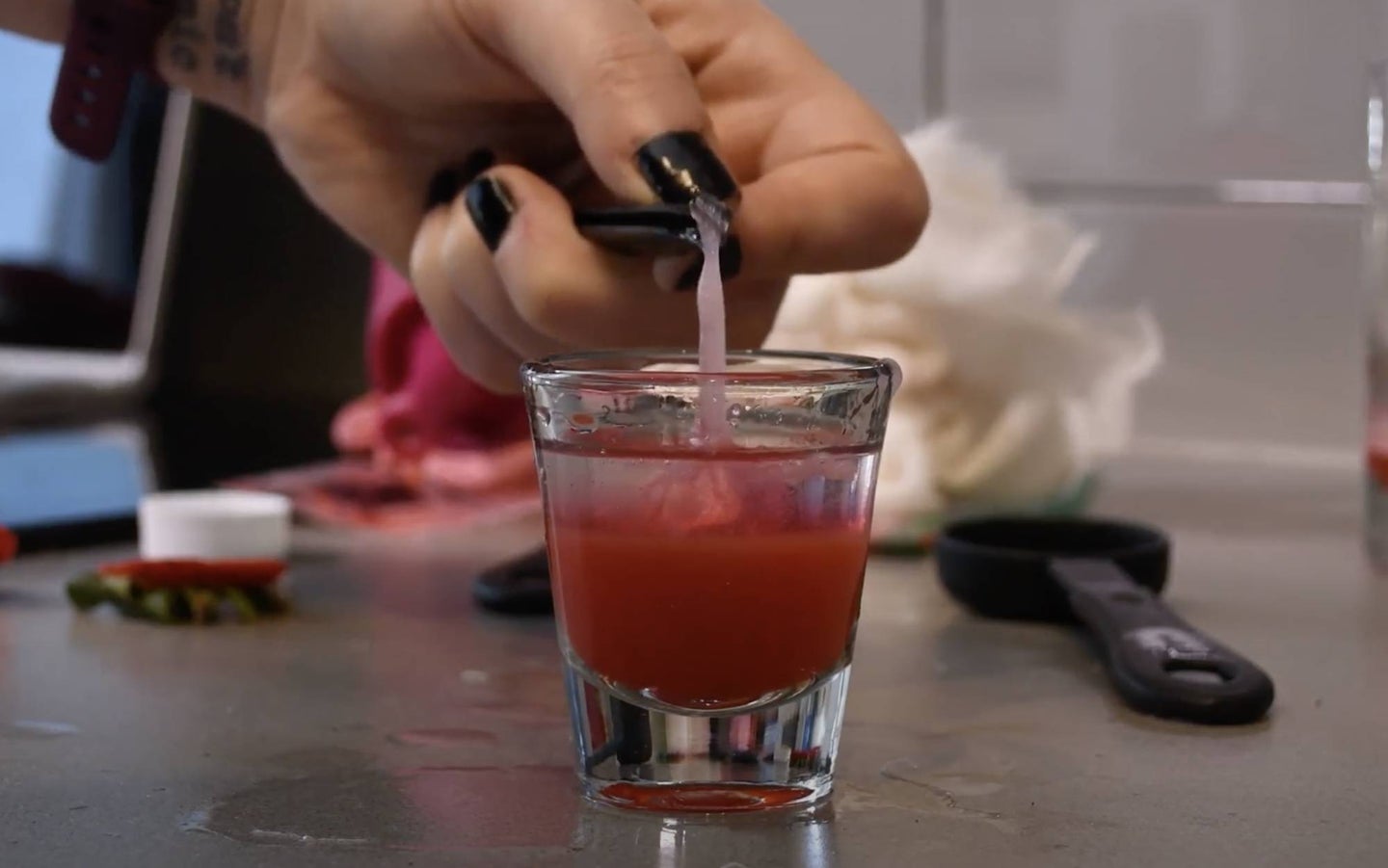A goopy guide to extracting strawberry DNA in your kitchen
Yes—that's pink snot-like DNA for you.

Maybe you’ve always wanted to be that snarky, brilliant lab technician who helps solve the case by pulling DNA from crime scenes on TV. Or perhaps you dreamed of using the genetic material of extinct species to create a Jurassic Park of your own. If you can relate to either of these scenarios, this experiment is for you.
Many of the materials scientists use to isolate DNA have simpler counterparts you can find in your own kitchen. With the help of salt, rubbing alcohol, and dish soap, you’ll be able to extract DNA from strawberries.
Why strawberries?
Beyond the fact that you’ll be able to eat any sweet, delicious leftovers, strawberries have a rare characteristic that makes them perfect for this experiment: they have a ton of genetic material.
DNA is basically the owner’s manual to an organism. Within the two twisting strands that make this complex molecule is all the information that any living being needs to develop, function, grow, and reproduce. This data is critical, so most species keep more than one copy of it in each cell.
[Related: Ten great science projects you can do with your kids]
Human beings are diploid, meaning each of our cells contain two copies of our DNA. But strawberries have eight copies in every cell, which means there’s plenty for us to extract.
Stats
- Time: 20 Minutes
- Difficulty: easy
Materials
- 1 quart-sized plastic zip-top bag
- 2 to 3 large strawberries (the riper they are, the easier they’ll be to work with)
- 1 tablespoon of liquid dish soap
- ½ teaspoon of salt
- 3 tablespoons of water
- 1/3 cup of 70% isopropyl rubbing alcohol (chilled in the freezer overnight)
Tools
- Cheesecloth, a coffee filter, or a fine mesh strainer
- Two small glass cups
- A shot glass (or a test tube)
- Tweezers (or a bamboo skewer)
Instructions
- Stem the strawberries. Then put the strawberries in the zip-top bag.
- In a cup, mix the salt, water, and liquid dish soap. This is your extraction mixture. When scientists isolate DNA in a lab, they’ll often use a similar mixture of salts and detergent to break open the cell walls that protect the DNA.
- Add the extraction mixture to the zip-top bag.
- Use your fingers to press on the bag and mash the strawberries. Keep mushing until there are no large pieces remaining.
- Place the cheesecloth, filter, or strainer over the small glass cup.
- Pour the contents of the bag into the filter. Use a spoon to mash the mixture against your filter and push as much liquid into the cup as possible.
- Transfer some of the strawberry mixture to the shot glass until it’s about half full.
- Take the isopropyl alcohol out of the freezer. Ideally, it spent the entire night there. But if you forgot, make sure it spent at least three to four hours on ice so it’s nice and cold by the time you need it. The colder it is, the less it will break down those delicate DNA strands as you extract them.
- Slowly pour the isopropyl alcohol down the sides of the shot glass. Keep going until you have a 1-inch deep layer on top of the strawberry mixture. You’ll notice a cloudy white substance starts to form on the surface. That’s the DNA.
- Use your tweezers or skewer to gently collect the white clump of DNA strands.
Wait, that’s DNA?

It is. You wouldn’t be able to see a single strand of hair from 20 feet away, but seeing a full head of hair from that distance is generally pretty easy. In a similar manner, you absolutely couldn’t see a single strand of DNA with your naked eye. But multiply eight sets of DNA by the number of cells in the strawberries you mashed up, and it adds up to one giant clump you can easily see without a microscope.
The science behind DNA extraction
DNA is important, so it’s well protected within the cell. Getting it out is a bit like performing a heist.
First, you’ll need brute force and special tools to break through the cell’s tough outside wall. Then you’ve got to break into the nucleus, where the DNA is safely locked away. Once you’ve done that, you’ve got to bypass the cell’s extra security measures—special destructive enzymes inside the cell that can dissolve DNA, including that of invaders such as viruses, or the strands you’re trying to extract.
Mashing the strawberries with your fingers helped to physically break the strong cell walls that protect the DNA. It also exposed more of the cells to our specialized break-in tool—the extraction mixture.
[Related: Five classic paper toys you can make when you’re bored (whether you’re in school or not)]
The detergent helps break apart the cell wall and the nuclear membrane. They’re both made up of lipids, which also make up that fatty, oily enemy the soap fights every day on your dirty dishes.
Once the extraction mixture has breached the cell’s outer wall, it makes its way inside the nucleus. Here, the salt comes in to break apart the proteins holding the DNA together, and keeping it inside the cell. As a result, the liberated genetic strands from multiple cells clump up together.
Finally, cold alcohol is crucial in making this a science experiment instead of a soapy strawberry daiquiri. It filters out genetic material from cell debris, which unlike DNA, is soluble in alcohol. The low temperature of the alcohol also helps slow down destructive enzymes that would otherwise break down the clumped-up DNA strands. This allows them to float to the surface as a cloudy, gooey foam you can see with your naked eye, and scare your roommate with.
